Why willows are a flexible tree choice: growing willows for animal fodder, weaving with willows, how to coppice willow

A willow might not be an obvious pick for your block, but it certainly could be the most ingenious.
Words Jane Wrigglesworth
1. Willow makes great animal fodder
It’s highly palatable, and organic-matter digestibility is around 60-65%, similar to normal, grassland summer pasture.
It’s terrific in times of drought. Trials by Massey University showed an improved lambing percentage for stock fed on willow (and poplar) forage compared with stock fed on drought pasture alone, which is why it often forms part of a drought resilience plan on larger farms.

If you want to give your livestock extra nourishing fodder during a drought, willow is a great option.
The foliage contains high levels of zinc and magnesium – important minerals for animal health – and secondary chemicals called condensed tannins, which increase ovulation rates and protein utilisation from forage.
READ MORE: How to make a willow bird feeder
READ MORE: Artisan willow weaver encourages community spirit
READ MORE: How to plant willows and poplars
Willows are also useful for controlling erosion on slopes, gullies and riverbanks, as their fibrous root systems help anchor the soil in place. They can help purify contaminated soils, sequester carbon in belowground biomass, minimise nutrient leach and, because they are thirsty trees, can help de-saturate waterlogged land.
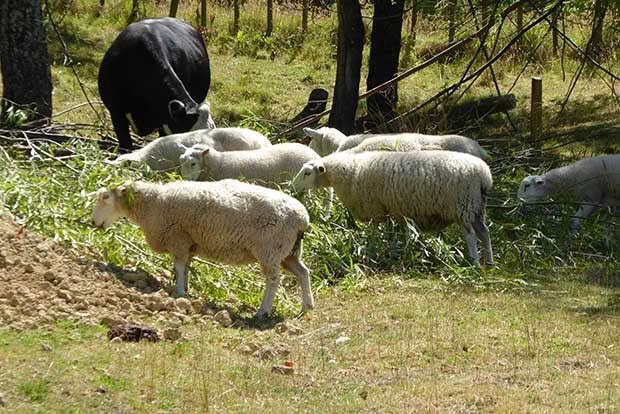
If your site gets hammered by wind, you might want to consider a willow shelterbelt. Wind is one of the main factors in determining the microclimate of a site, and wind chill or root rock can be a problem for a number of useful crops. Willows can also be useful when planted as a buffer zone between homes and growing zones and sources of air and noise pollution.
2. Your plant cuttings may benefit
Willow contains indolebutyric and salicylic acids, both plant hormones that can help improve the strike rate of cuttings.
Indolebutyric acid stimulates plant cell growth and root development and salicylic acid helps prevent pathogen growth, so it just might stop bacteria and fungi from infecting your cuttings.
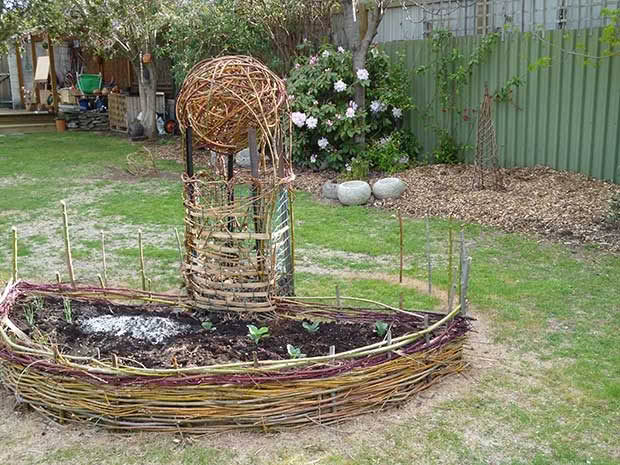
Fine willow branches can be shaped into natural garden sculpture and edging for garden beds.
An effective way of capturing these hormones for use on other plants is to make ‘willow water’. Use the tips of the willow where fresh growth is evident as this is where the hormones are most concentrated.
Remove any leaves and cut the stems into small pieces, 2-3cm long. Place in a heat-proof container and pour over boiling water. Leave to infuse overnight. Strain the liquid into a clean jar. Take your cuttings and stand them in the jar with the willow water. Leave overnight, then plant your cuttings as usual.
Willow-infused water can also be used on crops in the soil to encourage strong root growth.
3. You can get very artful
There is basketry, of course, but the art and handicraft applications of willow are much broader. Willow rods taken from a yearly coppiced stand can be used to make a range of handy baskets, but also to craft a variety of artistic garden displays such as sculptures, fences, screens and tepees.
Otago-based artist, landscape and garden designer Lynne Wilson holds willow weaving workshops to do just that. She teaches what the traditional weavers of the Loire Valley call ‘wild weaving’, which refers to the use of material harvested from the natural environment.
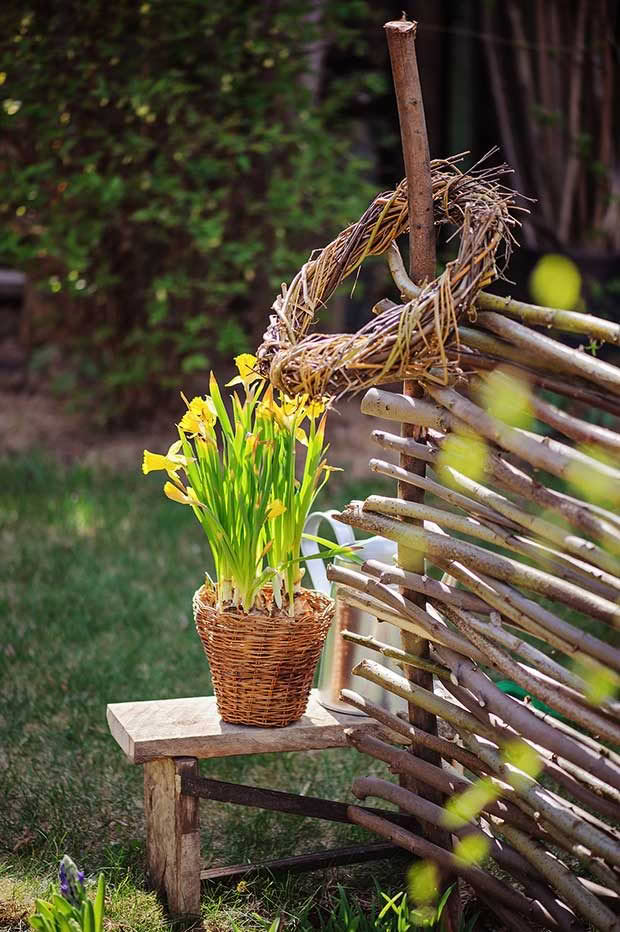
“I love working with willow for its suppleness and in many cases, the richness of colour in new growth from russet to apple green, that other materials such as vine prunings don’t offer,” says Lynne.
Lynne has worked with willow artistically for 15 years, since moving to Cromwell in 2002.
“My son, who was 12 at the time, enjoyed fishing, while I sat on the shores of Lake Dunstan offering encouragement. Eventually the need to be doing something with my hands caused me to look to my surroundings and the many varieties of willow that had been planted in recent years to naturalise the newly- formed lake.”
Lynne began with the construction of a sphere, the basis for three-dimensional sculptures.
“A sphere can become a torso, a head or simply stand alone as a pleasing form. It is free-form willow weaving 101 in my workshops.”
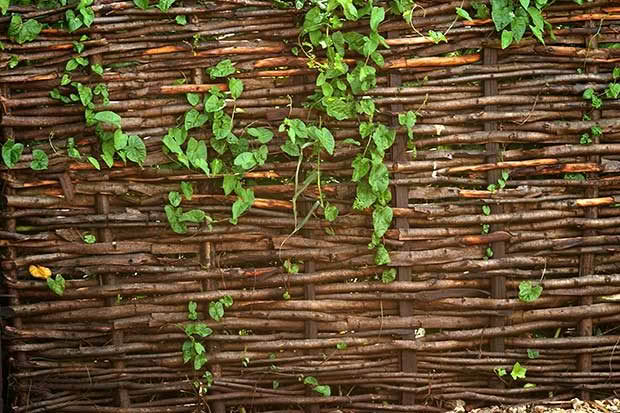
Willow looks great and is easy to weave into a screen.
Hurdles and living sculptures came next. The latter were not so successful in the dry Central Otago climate.
“The hurdles, however, have proven a quick and easy alternative to a hedge or screen,” she says.
Lynne uses Chinese willow (Salix matsudana) and violet willow (Salix daphnoides), among others, but she also harvests red-barked dogwood (Cornus alba ‘Siberica’), golden-twigged dogwood (Cornus sericea ‘Flaviramea’) and the common dogwood (Cornus sanguinea) for colour variation.

“The material suitable for weaving is usually found where a branch of a mature tree has been pruned or damaged. This is ideally 1-2 year growth, no thicker than a little finger at the base and without side branching.”
Coppiced willow is ideal. This is where the plants are pruned in such a way that they are stimulated to produce long, straight, flexible rods. Harvesting takes place during winter when the tree is dormant.
“It can be stored in a cool, dark place for later use,” says Lynn. “However, I prefer to harvest as I need it and while
at its most supple.”
Suppleness and colour may be lost over time, as a sculpture ages. However, fresh material may be added each season to refresh the look if you wish says Lynn.
“I do this with my willow balls, some of which are now several layers thick.”
Lynn’s workshops are popular, but these days they are restricted to those areas where she knows there is a good source of usable material, enough for 10 people to harvest approximately 60 rods each.

A living willow screen where young willow branches have taken root.
“Availability is always an issue and for that reason I restrict my workshops to the Cromwell area where I have been harvesting, and therefore coppicing, selected host trees for years.”
She avoids wastage if she can. “There is always some wastage but this can be used to start your own cuttings. These will eventually want to be large, thirsty trees so continued coppicing is essential.”

Salix matsudana Photo: RA Nonenmacher Wikimedia Commons.
Or you could use the leftover branches to make willow water.
HOW TO COPPICE WILLOW
One of the most beneficial things about willow trees is how easy they are to care for and how quick they
are to grow.
It can be useful, in different scenarios, to grow willows as specimen trees, barriers, hedges or living fences, or to coppice them to make use of the branches as a renewable resource for animal fodder or for basketry and artwork.

Coppicing is the practice of cutting willows back to ground level to maximise regrowth, making willow a valuable resource. Cutting trees back yearly results in multiple straight rods that can be used for various purposes, including weaving and fodder.
Coppicing every two or three years produces longer, thicker rods of 5-7cm in diameter and around 3m in length.
Coppicing on a longer cycle will allow you to grow firewood or thicker fence posts. In any of these scenarios, cutting back growth on a regular cycle will allow you to enjoy the same straight rods again and again in the coming years.
7 TIPS FOR GROWING WILLOW
1. Make sure you plant willow where it won’t interfere with home foundations or drainage systems.
2. Any willow branch that is at least 25cm long will take root when planted in soil.
3. Plant a branch to at least half of its depth and it will establish itself and send up side shoots.
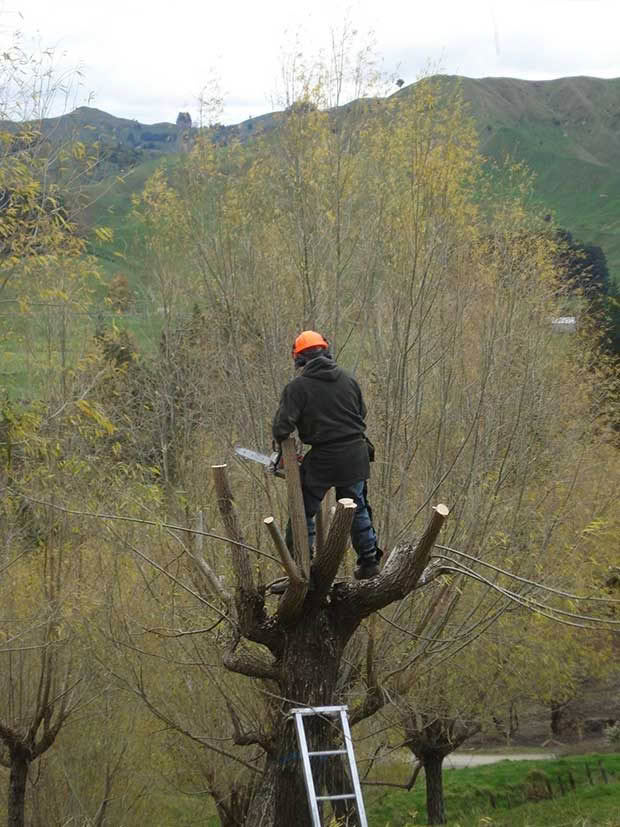
Pollarding willow is similar to coppicing, but instead of cutting at ground level, trees are cut off at head height or slightly higher.
4. Although willow needs little care once planted, you should take care to prepare the site well: weed well, lay a good, organic mulch, and water during dry weather while the trees establish.
5. The spring after planting, cut the willow down to 10cm above ground level and you will have established a willow ‘stool’. Rods growing out of this stool can then be coppiced or left to grow for three or four years and cut off around head height to create a pollarded tree.
Pollarding is a method of pruning that keeps trees smaller than they would otherwise grow, and multiple rods will grow from where it was cut.
6. Willow branches can also be planted in a row and the growing rods can be interwoven to create a living fence.
READ MORE
Artisan willow weaver Peter Greer encouraging community spirit in Golden Bay
Love this story? Subscribe now!
 This article first appeared in NZ Lifestyle Block Magazine.
This article first appeared in NZ Lifestyle Block Magazine.
